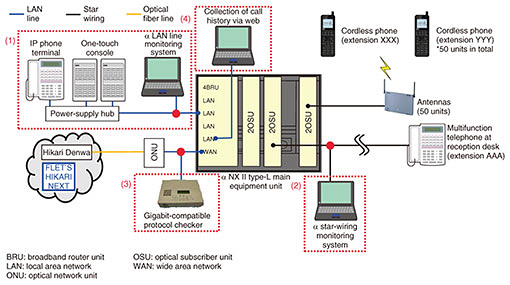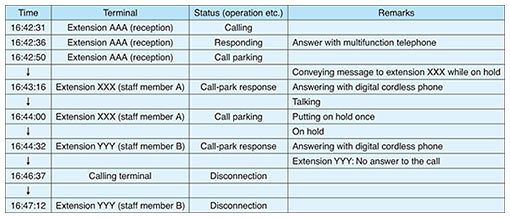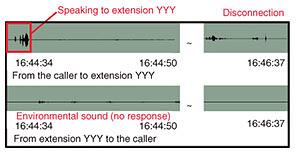 |
|||||
|
|
|||||
|
Practical Field Information about Telecommunication Technologies Vol. 17, No. 2, pp. 70–73, Feb. 2019. https://doi.org/10.53829/ntr201902pf1 Investigation of the Cause of Disconnection of Call Parking on a Business PhoneAbstractNetwork-interface engineers at the Technical Assistance and Support Center are providing technical support for local maintenance personnel who deal with customers using IP (Internet protocol) services and public switched telephone network related services. This article describes a problem concerning the disconnection of call parking in business phones. This is the fiftieth article in a series on telecommunication technologies. Keywords: call park, business phone, line monitoring system 1. IntroductionNetwork-interface engineers at the Technical Assistance and Support Center are providing technical support for local maintenance personnel who deal with customers using Internet protocol (IP) services such as FLET’S HIKARI NEXT and public switched telephone network (PSTN)-related services such as analog lines. This support ranges from conducting investigations by on-site testing to proposing ways to handle technical difficulties in order to solve problems whose causes are difficult to identify. Customers use services in diversified ways, and thus, two approaches are used to investigate the causes of any technical problems. First, to investigate the Ethernet segment used by IP services, a method for analyzing IP packets based on packet capture is utilized. Second, to investigate analog and ISDN (Integrated Services Digital Network) lines used by PSTN-based services, a method for analyzing signals using an oscilloscope and protocol analyzer is utilized. We are also utilizing the tools developed by the Technical Assistance and Support Center to investigate terminals such as business phones. These tools include the α line monitoring system capable of collecting the unique signals of business phones. The problem described in this report concerns the disconnection of call parking in business phones. We explain how this kind of problem was analyzed by utilizing the above-described analysis methods and the tools developed by the Technical Assistance and Support Center. 2. Summary of problem and survey methodThe call-park function is used as follows. All incoming calls on an external line to the customer’s main phone number are received by a multifunction telephone installed at the reception desk. After determining who to connect each call to, the receptionist uses the call-park function to hold the calls and then transfers the calls to the appropriate staff member, each of whom carries a digital cordless phone. However, the following event occasionally occurred. When an incoming call on an external line was held using the call-park function to be accepted by a staff member, the line was put into an active call state (the line being engaged) while the staff member who should answer the call was being called. The customer explained that the status of the LED (light-emitting diode) indicator of the call-parking line on the multifunction telephone (at reception) when the event occurred changed from blinking (call-park state), to continuously lit (call state), and, after a while, to unlit (disconnected state). When the status of the caller of the external-line incoming call where the problem occurred was checked, it became clear that the status in which there was no answer to the call (after the call-park function was initiated) continued for a while, before the line was eventually disconnected from the caller side. To conduct normal call operations, the customer set all digital cordless phones carried by staff members to respond to all call-park calls via line keys. Local maintenance personnel checked and/or changed the setting of the main equipment unit or replaced some terminals, however, these countermeasures did not solve the problem. Accordingly, the Technical Assistance and Support Center conducted an on-site investigation. The configuration of the customer’s equipment is shown in Fig. 1. We considered the possibility of misoperation or failure of the multifunction telephone and digital cordless phones occurring, so in our on-site investigation, we added the following four functional elements to the customer’s system: (1) call-park response status monitoring for 50 digital cordless phones combining an α LAN (local area network) line monitoring system and IP telephone/one-touch console; (2) operation status monitoring for the multifunction telephone (reception) using an α star-wiring monitoring system); (3) IP packet capture by a gigabit-compatible protocol checker, and (4) records (call history obtained via web) of call information of all calls, including extensions and external lines of the main equipment unit.
To monitor the call-park response status of all 50 digital cordless phones, one IP phone for monitoring incoming calls on an external line and two one-touch consoles for monitoring the response status of the digital cordless phones were newly registered in the main equipment unit, and the terminal response data were acquired by the α LAN line monitoring system. The response state of the incoming calls on an external line and the time when a call was incoming can be determined from the terminal response data of the IP phone, and the call-park response state and the time that the line was switched to the call-park state of each digital cordless telephone can be understood from the terminal response data of the one-touch consoles. In this way, we constructed a measurement system to clarify the call-park response state by analyzing these data. 3. Analysis of collected dataWe analyzed the data collected in our investigation as follows. 3.1 α LAN line monitoring system*1When we checked the park-hold response state of the 50 digital cordless phones when the park-hold problem occurred, we confirmed that a different digital cordless phone (staff member) from the destination phone was responding to the park hold. The operational status of each terminal when the park-hold problem occurred is listed in Table 1. Although calls transferred from extension AAA (reception) to the digital cordless phone of extension XXX (staff member A) are temporarily parked at 16:44:00, at 16:44:32, a park-hold line was responded to with the digital cordless telephone of extension YYY (staff member B), that is, not extension XXX. After that, the caller disconnected at 16:46:37, and at 16:47:12, extension YYY (staff member B) disconnected the line.
3.2 α star-wiring monitoring system*2The results of checking the data collected by the α star-wiring monitoring system revealed that the multifunction telephone at reception was correctly operated to transfer incoming calls via the call-park function. 3.3 Gigabit-compatible protocol checkerAn audio-data waveform constructed from packet-capture data when the call-park problem occurred (only after the call-parking line was responded to by extension YYY) is shown in Fig. 2. Although the caller is speaking to extension YYY, the voice waveform from extension YYY to the caller cannot be confirmed because there is no verbal response to the caller’s utterance from extension YYY. The amplitude of the sound was barely confirmed after the call-park response was confirmed except for a rustling sound—as if something was rubbing against something else—or the sound of the surrounding environment.
3.4 Call history obtained via webWe found that the NX II type-L main equipment unit was operating normally because the call information recorded in the call history provided via web and the number of calls to and from the external line clarified from the packet-capture data were in accord.
4. Estimation of the cause of call-park problemWhen staff members carry a digital cordless phone at work, they often put the phone in their breast pocket; as a result, it is conceivable that the line key flashing in the call-park state might be accidentally pushed by another object (e.g., a pen), and the phone might unintentionally respond to a parked call. For that reason, it is presumed that the staff member who responded to a parked call did not notice that the digital cordless phone was in a call state (accounting for the rubbing or environmental sound rather than a verbal response from extension YYY), and there was no response to a call from a caller. 5. CountermeasuresSince the customer’s setting was to respond to all parked calls by pressing the line key of all their digital cordless phones, the above-described unintended call-park response occurred. Because of the fact that users often put their digital cordless phones in their breast pockets along with other objects, we proposed the following three measures to prevent the unintentional call-park response. 1. Utilization of key lock functionBy releasing the key unlock every time an operation is required, it is possible to prevent erroneous responses to parked calls by unintended button pressing. 2. Utilization of individual on-hold functionBy using the individual on-hold function (i.e., pushing the hold button) of the multifunction telephone (reception), it is possible to prevent digital cordless phones other than the destination phone from entering a state in which a hold cannot be responded to. 3. Utilization of park-hold functionWhen sending an external-line call from the digital cordless telephone, the customer was pressing the line key to acquire the line and then pressing the destination telephone number. In such an operation, there is a risk that when a staff member unconsciously presses a line key in an attempt to make an external-line call, he/she will inadvertently respond to a parked call. Therefore, the staff member with a digital cordless phone uses the park-hold function that is provided separately from the call park key, it is possible to prevent a false reply to a parked call. 6. Concluding remarksIn the case presented in this report, the problem concerning the disconnection of call parking in business phones was solved by using a measurement system utilizing an α LAN line monitoring system to monitor the operational condition of 50 digital cordless phones. From now onwards, the Technical Assistance and Support Center will analyze the signals and data using various tools at each interface and contribute to the resolution of problems. |
|||||



